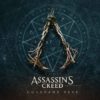From the moment that Transference was announced, I was intrigued. The project was first revealed last year and claimed to be a VR supported thriller but also an attempt to meld both film and video game. The premise is great, the platform is better than ever before and the pedigree behind it is somewhat credible. Despite all this ambition and talent, Transference fails to capitalize on its unique premise and ultimately feels like a been-there-done-that of VR conventions, which is a bit of a shame, although its unique presentation is eventually what makes it memorable.
Transference revolves around the story of Raymond Haynes, a computer scientist who has begun experimenting on his family by digitising the contents of their brains, kind of. Each family member has their own consciousness uploaded to the system and each has their own simulation of events that you, as an unnamed researcher must explore. As you delve deeper and deeper into the simulation, it becomes obvious that something isn’t quite right with the data and that the data itself may have been obtained in a questionable manner. If my awkward language isn’t a giveaway here, I’ll be quite blunt; Transference is a better experience the less you know about it going in. The story is easily what drives most of the game, being drip fed to you in minute detail but eventually coming together to tell a compelling if not slightly twisted story of a family’s suffering. Think of it as a more technologically fueled version of What Remains of Edith Finch, albeit a much more concise one.
If my awkward language isn’t a giveaway here, I’ll be quite blunt; Transference is a better experience the less you know about it going in. The story is easily what drives most of the game, being drip fed to you in minute detail but eventually coming together to tell a compelling if not slightly twisted story of a family’s suffering. Think of it as a more technologically fueled version of What Remains of Edith Finch, albeit a much more concise one.
From the get-go, you’ll be loaded into the world of Transference with little to no context as to what you’ve got to do or where you are. Bit by bit, you’ll slowly piece together the story by walking from room to room, inspecting items and completing very simplistic puzzles to unlock more of the home to explore. You’ll largely be in the same area, exploring it from the different perspectives of each family member, which lets you learn the space quite well by the time you’re done. The thing that’s most unique about Transference is the mood and the atmosphere of the game, which is absolutely dripping from the moment you load things up for the first time. The whole premise of the game – that it takes place in a glitchy corrupt simulation – means the environments warps, twitches and contorts to give an air of unpredictability to the world. I wouldn’t quite call Transference a horror game, as I don’t think it aims to explicitly scare players, but it feels tense from beginning to end, especially if played in VR.
The thing that’s most unique about Transference is the mood and the atmosphere of the game, which is absolutely dripping from the moment you load things up for the first time. The whole premise of the game – that it takes place in a glitchy corrupt simulation – means the environments warps, twitches and contorts to give an air of unpredictability to the world. I wouldn’t quite call Transference a horror game, as I don’t think it aims to explicitly scare players, but it feels tense from beginning to end, especially if played in VR.
While it’s playable with and without VR, you’d be doing a great disservice to yourself and the game if you chose to experience Transference without it. Despite some annoying and honestly flat jump scares peppered throughout the story, playing in VR gives the game a real sense of place and presence. The way the story is presented, with sequences of live action footage blended into the game world, helps to give weight to the idea that you’re somebody who’s stepped into a digital world too. It’s obviously not essential and playable without it, but virtual reality gives Transference an air of authenticity that I can’t imagine could be captured anywhere else on any other medium.
However, there is a glaring issue with Transference I’d be remiss to address. Despite the unique premise, as a game, Transference hardly breaks any new ground in the way it plays out. The story is told in a way that’s so obtuse that it’s hard to garner any emotional response to the events that play out in front of you. Similarly, the main beats that the gameplay hits have been done to death even in the first wave of VR titles and the whole thing just feels a little bit late to the party. A year or so ago this would have been something truly special. But right now, it feels like every other trippy sci-fi inspired thriller akin to the likes of SOMA and Observer, though I’ll admit Transference is much more colourful.
It’s all over a little bit too quickly too. With Transference, I really wanted to immerse myself in the world of the Haynes household and did my best to explore every nook and cranny. Despite this commitment to exploration, I was watching the credits roll after about two or so hours of gameplay. For VR, this felt just right in terms of comfort of the experience. For those not playing in VR, the game is priced at AU$38 which feels like a little bit much for such a brief experience. Despite this, Transference’s presentation is top notch. While not the most technically impressive game, the way the world is built to portray a typical home with an atmosphere that you can’t trust is downright masterful. The creatives behind this strange yet uncertain world should be commended for crafting something so authentic. Unpredictable and unnerving sound design, whether it be haunting echoes down hallways or the jitter of a door, helps drive home the tense atmosphere of the Haynes household.
Despite this, Transference’s presentation is top notch. While not the most technically impressive game, the way the world is built to portray a typical home with an atmosphere that you can’t trust is downright masterful. The creatives behind this strange yet uncertain world should be commended for crafting something so authentic. Unpredictable and unnerving sound design, whether it be haunting echoes down hallways or the jitter of a door, helps drive home the tense atmosphere of the Haynes household.



